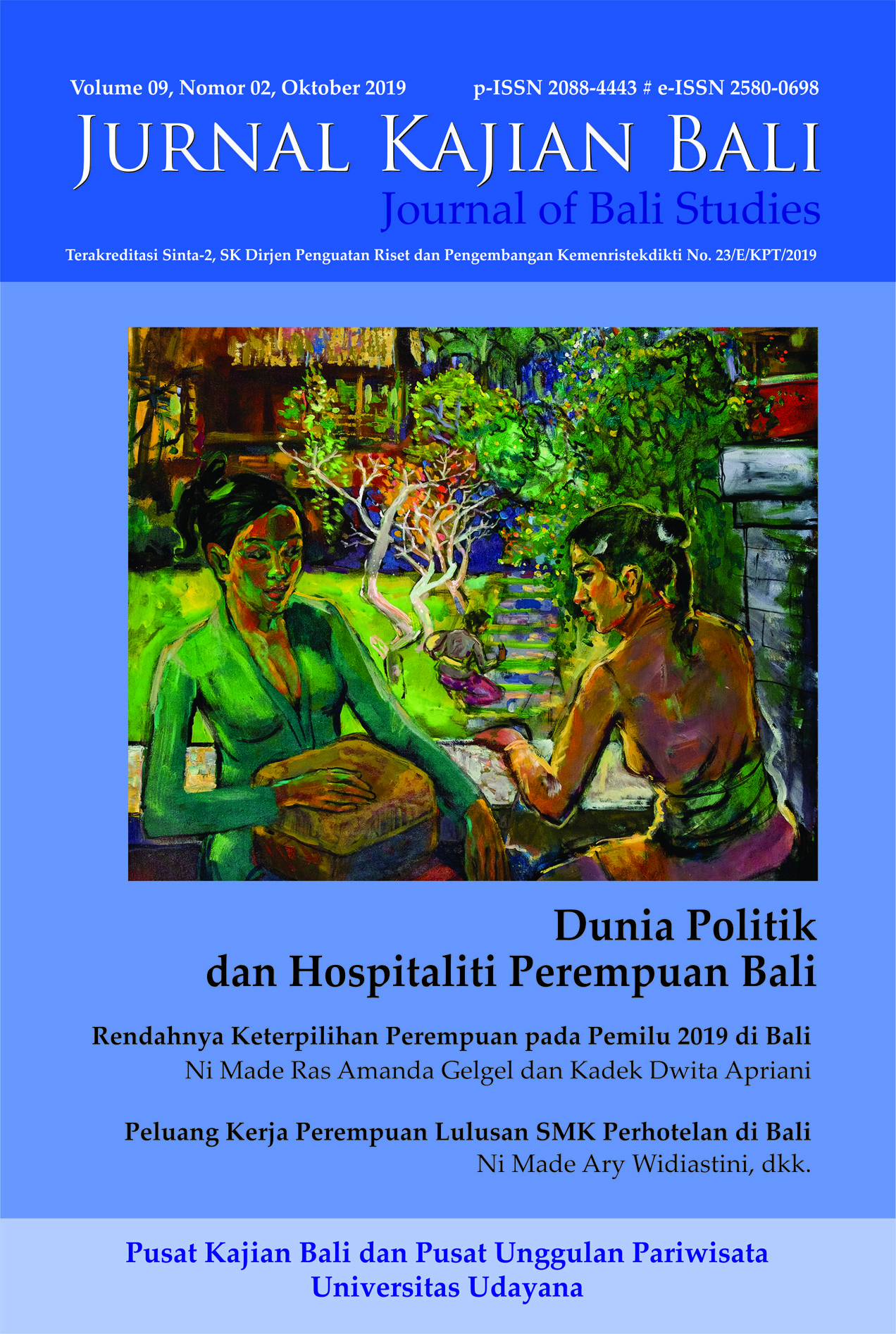Unsur-unsur Pengetahuan Sosial dalam Cerita Rakyat Bali Aga dan Buku Pelajaran Sekolah Dasar Zaman Kolonial Belanda
Abstract
This article analyses the elements of general knowledge in the folklores of Balinese Bali Aga and in the elementary school-text books of the Dutch colonial period. The analyses focuses on how narrative texts which usually consider as fiction and contain unreal information are also expressing general knowledge and social and cultural facts. The object of this study are selected folktales of Bali Aga published in book form in 1987 and expositional text and short stories included the school text books published in the 1910s. Of the two books, 10 texts were chosen for discussion. Data were analysed with rhetoric and content analysis theories that give attention to the content instead of structure of texts. This article concludes that folklore, short story, and other forms of fictional genre are rich in general knowledge on social and cultural life and description on factual matters similar to expositional text genre. Thus, like expositional texts genre, narrative texts have the ability to tell stories and also to convey varieties of general knowledge related to the society that owned the stories.
Keywords: Balinese language, narrative text, expositional text, fact and fiction, content analysis
Downloads
References
Citraningtyas, Clara Evi. 2015. “Indonesian Folktales in The Past, Present, and Future: Are We Reluctant to Change?” dalam Resti Nurfaidah (ed). Sastra Kita: Kini, Dulu, dan Nanti. Bandung: Unpad Press, hlm. 122—131.
Damono, Sapardi Djoko. 2011. Sosiologi Sastra. Jakarta: Editum
Danandjaja, Djames. 1995. “A Comparative Study of Japanese and Indonesian Folklores”, Southeast Asian Studies, Vol. 33, No.3, December 1995, hlm. 202—214.
Dananjaya, James. 1986 [2007]. Folklor Indonesia, Ilmu Gosip, Dongeng, dan lain-lain. Jakarta: Pustaka Utama Grafiti.
Keraf, Goris, 1982. Argumentasi dan Narasi. Jakarta: Gramedia.
Keraf, Goris. 1981. Eksposisi dan Deskripsi. Ende Flores: Nusa Indah.
Kleden, Ignas. 2004. Sastra Indonesia dalam enam Pertanyaan; Esai-esai Sastra dan Budaya. Jakarta: Garfiti/Freedom Institut.
Morse, Ronald A. 1990. Yanagita Kunio and the folklore movement: the Search for Japan’s National Character and Distintiveness. New York: Garland Pub.
Nuria, Halida. 2013. “Kekerasan Orang Tua Terhadap Anak dalam Cerita Rakyat Tolire Gam Jaha Dari Ternate”. Tesis Prodi Magister Kajian Budaya Pascasarjana Universitas Udayana.
Parmini, Ni Putu. 2015. Eksistensi Cerita Rakyat dalam Pendidikan Karakter Siswa SD di Ubud”, Jurnal Kajian Bali Vol. 5, No. 2, November, pp. 441-460.
Pasek, I Made. 1918. Aneka Warna Tjakepang Kaping Kalih Papaosan Bali Kesoerat Antoek Akasara Belanda. Batavia: Landsdrukkerij
Pollard, Nani. 2016. “Pengajaran Bahasa Indonesia untuk Pembelajar Asing melalui Cerita Tradisi Lisan”. (Sumber: https://www.google.com/url?sa=t&rct=j&q=&esrc=s&source=web&cd=1 &cad=rja&uact=8&ved=0ahUKEwim6pf4idTNAhUMqY8KHdNUBRIQFggeMAA&url=http%3A%2F%2Fwww.ialf.edu%2Fkipbipa%2Fpapers%2FNaniPollard.doc&usg=AFQjCNHZDB1xfLZDf2Ur56vtJ-XIvnVYxg, diakses 02-07-2016).
Putra, I Nyoman Darma. 2019. “Nusantara Bertutur Arah Baru Tradisi Dongeng Indonesia”, makalah dalam seminar “Literasi Pembentukan Karakter Anak Melalui Dongeng” di auditorium Redha Gunawan Kampus IKIP PGRI Bali, Denpasar, 29 Maret 2019.
Rata, Ida Bagus, dkk. 1987. Cerita Rakyat Bali Desa Tenganan, pedawa, Tigawasa. Denpasar: Dinas Kebudayaan provinsi Bali.
Reuter, Thomas A. 2005. Custodians of The Sacres Mountains: Budaya dan Masyarakat di Daerah Pegunungan Bali. Jakarta: Yayasan obor Indonesia.
Reuter, Thomas. 2002. Custodians of the Sacred Mountains: Culture and Society in the Highlands of Bali. Honolulu: University of Hawai’I Press.
Santoso, Romin Adi, Dwi Sunaryono, dan Isye Arieshanti. 2013. “Rancang Bangun Aplikasi Buku “Dongeng” - Kumpulan Cerita Rakyat Interaktif Berbasis iOS”, Jurnal Teknik Pomits Vol. 2, No. 2, pp. A-407-A412.
Sari, Ida Ayu Laksmita. 2016. “Memperhalus Cerita Rakyat untuk Pembentukkan Karakter: Kajian atas Narasi Kekerasan dalam. Cerita Rakyat Bali dan Jepang”, dalam I Made Suastika dkk. (ed) Tradisi Lisan sebagai Kearifan Lokal, Nilai Budaya, dan Pendidikan Karakter, pp. 145-151. Denpasar: Pustaka Larasan.
Simpen AB, Wayan. 1986. “Catur Desa: Tigawasa, Sidatapa, Pedawa, Cempaga” dalam Laporan Penelitian Fakultas Sastra Universitas Udayana.
Suaka, I Nyoman. 2018. “Refleksi Kekerasan dalam Rumah Tangga dalam Cerita Rakyat Bali Tuwung Kuning: Analisis Feminisme”, Jurnal Kajian Bali, Vol. 8, No. 2, Oktober, pp. 63-84.
Suarka, I Nyoman dan AA Gede Bawa. 2018. “Cerita Klasik “Tantri Kamandaka” sebagai Sumber Ekonomi Kreatif”, Jurnal Kajian Bali Vol. 8, No. 1, April, pp. 181-200.
Teeuw, A. 1984. Sastra dan Ilmu Sastra: Pengantar Teori Sastra. Jakarta: Dunia Pustaka Jaya.
Wijana, Dewa Putu. 2004. “Cerita Rakyat dari Bali: Beberapa Kejanggalan Linguistik”, Humaniora, Vol. 16, No. 1, Februari, pp. 88 – 95.

This work is licensed under a Creative Commons Attribution 4.0 International License.



















